Stars and Stripes Newsboy
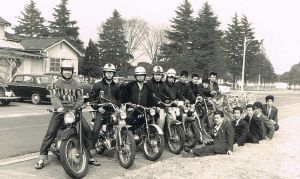
In 1964 (the year of the Tokyo Olympic), when I was a first year high school student, I was looking for a casual newspaper delivery work to support myself due to my father's chronic illness. I had heard there were some vacancies on newspaper delivery positions within a Fuchu American Base. I asked at the front security gate of the Base, and luckily I was showed an office inside the Base straightaway.
I was fairly comfortable because both office and delivery staff was all Japanese, and the delivery was only at the evening. My high school was located within 5 minutes of a bicycle ride, which was well desirable. Thus, I decided to take that offer.
Now this is only a picture I have of the Stars and Stripes Newsboys and their office staff. Sitting on motorbikes and bicycles are the newsboys, and sitting on grass are office staff. Takahisa Manager is sitting at the front while Ken Torikoshi is at the far end.
The picture was taken at the front of the Fuchu Base office, seeing a helicopter pad on their right. Currently the site became a home of Fuchu Art Theater. There is now a Japanese Air force base at the site where trees used to be. The office of PS&S was next to a movie theater on the left where we used to watch free English movies.
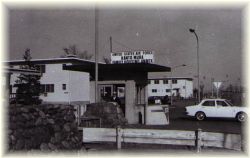
Paper Delivery Began in Kanto-mura
A hotel on the route 20 now used to be the front gate of the Kanto-mura (currently around Ajinomoto Football Stadium), where I used to ride my push bike to. At the dispatch depot, I loaded my papers onto the bicycle for delivery. I recall it used to take a couple of hours to deliver them all. After completing my delivery, I used to drop by the office to have a little chat with others before heading home.
4 units per block, 220 blocks in total
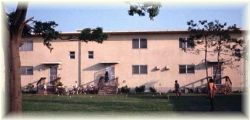
I kept visiting the Kanto-mura regardless of rainy and windy days. Leaving my bicycle at the carpark while I deliver 12 papers holding in my arm for a group of 12 units per the U shaped complex. There were 6 Newsboys at that time, delivering about 150 papers per person, I recall. All deliveries were to the first floor units, so it wasn't much trouble for us. I think there used be about 80% of households subscribing the paper that time.
Delivery method in Kanto-mura
At the Kanto-kura, instead of posting a paper to a mail box, we used to fold the paper in 4 and left behind the sliding door handle. Sometimes, a pet dog followed us running, and bit my leg from behind (not a good moment).
Father passed away
June in 1965 (Showa 40), at my second year high school, my father past away due to cancer, and he was 54 years old.
Fee collection
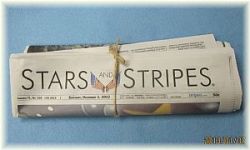
Once a month, I collected the subscription fee from the readers, and we got used to know each other. It was a great opportunity leaning English. The fee was $2.50, and everyone was on time. Sometimes, people gave me some chocolate retreat.
Bicycle superseded by motorbike
At 16, I gained a motor bike license and bought a motor bike for delivery. I vaguely remember my wage was around 7000yen. The motor bike should be either 'Runpet' by Tohatsu or 'Sports Kab' by Honda.
Newsboys
There used to be roughly 10 Newsboys in total (6 in Kanto-Village), and mainly consisted of high school students around the Kanto-Village and the Fuchu Base. We tended to use motor bikes rather than bicycles because Mr. Yoshiyuki Hanzawa liked motor bikes. Everyone was well and there weren't much missed deliveries, however, we sometimes covered a sick Newsboy by delivering other areas, checking against the delivery list.
Ham radio friend
One day, I spotted a Yagi-Antenna on top of the complex roof, and asked to see if the antenna was for Ham Radio. That was the Jim's house. We soon became close friends over Ham Radio and visited his house on Sundays.
Changed from Kanto-mura to Fuchu Base
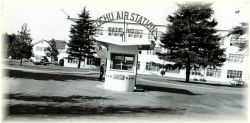
A year later, my delivery area had changed from Kanto-mura to Fuchu Base. I thought that was a lucky move being closer to my house, but soon after I realized the area was harder to collect the subscription fees due to single officers being home late. I often checked a light from outside before knocking a door.
Delivery method in Fuchuu base
The Fuchu Base was like a hotel, so we could slip a paper through a gap underneath the door. The trick was to not bend your back. If you accidentally threw a paper into a wrong room, there was no chance of retrieving it back. Sometimes paper could disappear if you didn't slip it in fully.
Quit after graduation for a new job
In spring of 1967 (Showa 42), I found a full time work and regrettably quit the Newsboy. The 3 years of being a newsboy added unforgettable experience to my life and formed a solid step to my next journey.
Thanking to colleagues
I am sincerely thanking Mr. Takahisa (Manager), Ken, Teru, and other staff members for such a joy and memory. Later, the Kanto-Village and the Fuchu Base had been returned to Japan, and PS&S office has been moved to Yokota Base. 46 years has passed, and I haven't been to the office since then.
50th Anniversary of Fuchu Technology High School
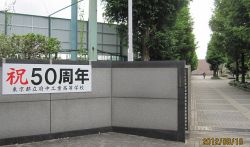
It was my high school's 50th anniversary in 2012. The school was 1km away from my house, and 500meter from the Fuchu Base. The neighborhood used be a full of farm land back then, but now there are a Wakamatsu Primary School, a supermarket and shops, a home centre, many apartment blocks and houses. The old school building has been replaced by a new one. I was the second graduates from my high school that means there has been almost a half a century. There used to be few newsboys from this high school too.
Giants, Taiho Sumo Wrestler and Japanese egg omelette
Baseball and Sumo wrestling used to be our main entertainment during the Japan's high growth economy in 1960s. Mr. Nagashima, Giants, was my favourite baseball player. I was so excited watching the Sumo wrestling on a Black and White TV. Around that time, one of the most popular lunch box menus was a Japanese egg omelette. Popular songs were `Shiawase-nara Tewo Tatakou` by Kyu Sakamoto, `Ai to Shi wo Mitsumete` by Kazuko Aoyama, `Ankotsubaki ha Koino Hana` by Harumi Miyako, `Gakusei Jidai` by Peggy Hayama, `Yawara` by Hibari Misora, `Yoitomake no Uta` by Akihiro Maruyama, `Gomenne Jiro` by Chiyo Okumura, `Kimito Itsumademo` by Yuzo Kayama, etc.
Site of ruins of the Kanto-mura origin
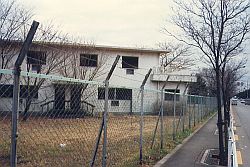
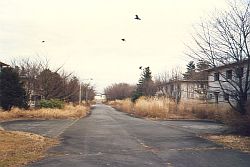
「takurama photo gallery」
Some images have been used on this website.
This is the road where I used to pedal my bicycle for the paper delivery.
I used the photograph
Some old images were found on the internet. I understand all permission for use of these images on this website has been granted, however, if there is any issue, please do not hesitate contacting me. I am happy to omit them immediately. I'd like to take this opportunity to thank the owners of these images. There is a direct link for your easy reference.
Chofu.org
ReoCities
I was impressed in particular [sayonara Kanto-mura]